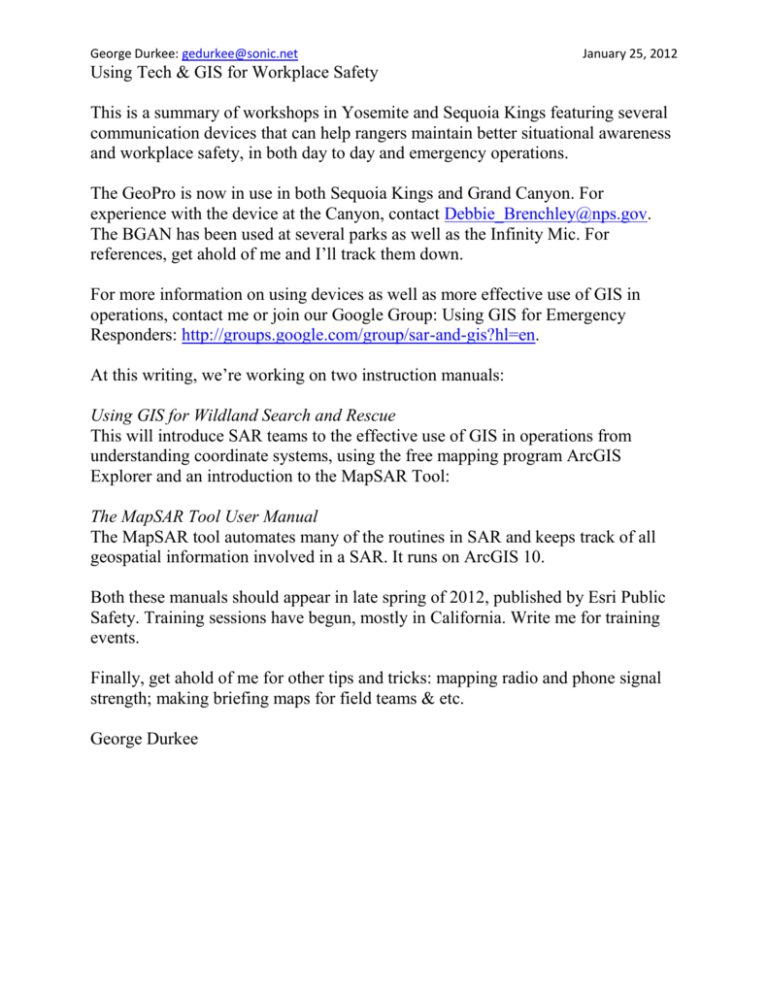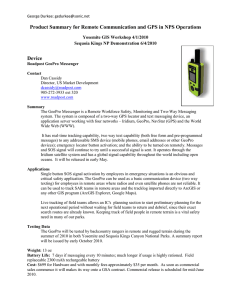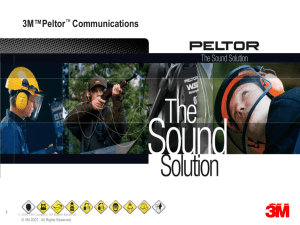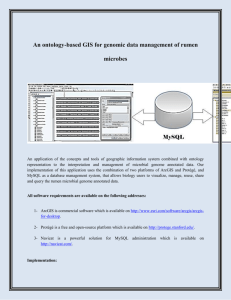Using Tech and GIS in Workplace Safety and Situational Awareness
advertisement

George Durkee: gedurkee@sonic.net January 25, 2012 Using Tech & GIS for Workplace Safety This is a summary of workshops in Yosemite and Sequoia Kings featuring several communication devices that can help rangers maintain better situational awareness and workplace safety, in both day to day and emergency operations. The GeoPro is now in use in both Sequoia Kings and Grand Canyon. For experience with the device at the Canyon, contact Debbie_Brenchley@nps.gov. The BGAN has been used at several parks as well as the Infinity Mic. For references, get ahold of me and I’ll track them down. For more information on using devices as well as more effective use of GIS in operations, contact me or join our Google Group: Using GIS for Emergency Responders: http://groups.google.com/group/sar-and-gis?hl=en. At this writing, we’re working on two instruction manuals: Using GIS for Wildland Search and Rescue This will introduce SAR teams to the effective use of GIS in operations from understanding coordinate systems, using the free mapping program ArcGIS Explorer and an introduction to the MapSAR Tool: The MapSAR Tool User Manual The MapSAR tool automates many of the routines in SAR and keeps track of all geospatial information involved in a SAR. It runs on ArcGIS 10. Both these manuals should appear in late spring of 2012, published by Esri Public Safety. Training sessions have begun, mostly in California. Write me for training events. Finally, get ahold of me for other tips and tricks: mapping radio and phone signal strength; making briefing maps for field teams & etc. George Durkee George Durkee: gedurkee@sonic.net January 25, 2012 Product Summary for Remote Communication and GPS in NPS Operations Yosemite GIS Workshop 4/1/2010 Sequoia Kings NP Demonstration 6/4/20 Device Summary and Need Within NPS Operations Recent and ongoing advances in technology have the potential to make many aspects of ranger and NPS operations more effective, efficient and meet the essential need for safety in the field. Both day to day and emergency operations have a critical need for dependable communication, keeping track of field personnel and recording and archiving that information for later evaluation. Use of GIS software and a number of tech devices now being introduced can be combined to provide solutions to these operational needs. For instance: A radio mic from Infinity has the ability to show the GPS location, including vector and distance, to other mics transmitting on the same radio system. It will also record waypoints (clues, critical locations, photo points etc.); has two way texting capability; an emergency beacon; and will save a continuous track log of travel by field personnel for later upload to a computer. Separately developed software allows the Infinity mic to display, in real time, the combined tracks, waypoints and text messages of all mics in the field on ArcGIS Explorer, the free mapping software (like Google Earth) from ESRI. A portable (6 lb) battery operated satellite link from Inmarsat allows rapid setup of a high speed data and voice/phone link anywhere a 30 degree horizon is visible. A computer or smart phone can be directly connected for voice or computer based Tx/Rx of documents, photos, reports, video or any other data exchange to or from field operations. A ruggedized GPS unit from RoadPost provides continuous GPS tracking via satellite; two way texting capability; emergency locator activation; pre-programmed text messaging; and web-based display of all information transmitted. It will also queue all data until a successful satellite lock is achieved and then transmit or receive data (currently, several other systems discard information if no link is available). This is a rapidly emerging field and many other devices and software applications are appearing on the market. Recent experience suggests that use of GIS related software and technology has been spotty in units of the NPS. As such, there is a need for the NPS to evaluate devices and software, work with developers to make our specific needs known, recommend an integrated package that will work together under field conditions; and develop simple training materials for field rangers and ICS personnel to use this technology on operations as well as day to day work. Also important to note is the level of genuine excitement and enthusiasm that developers from ESRI and others show for our efforts. This is something that needs to be taken advantage of while they have the time and ability to help us. As a ranger in Sequoia Kings observed, this technology has the potential to move much of our “office culture” out to the field where we can be more effective. George Durkee: gedurkee@sonic.net January 25, 2012 Device Roadpost GeoPro Messenger Contact Dan Cassidy Director, US Market Development dcassidy@roadpost.com 905-272-3933 ext 320 www.roadpost.com Summary The GeoPro Messenger is a Remote Workforce Safety, Monitoring and Two-Way Messaging system. The system is composed of a two-way GPS locator and text messaging device, an application server working with four networks – Iridium, GeoPro, NavStar (GPS) and the World Wide Web (WWW). It has real-time tracking capability, two way text capability (both free form and pre-programmed messages) to any addressable SMS device (mobile phones, email addresses or other GeoPro devices); emergency locator button activation; and the ability to be turned on remotely. Messages and SOS signal will continue to try until a successful signal is sent. It operates through the Iridium satellite system and has a global signal capability throughout the world including open oceans. It will be released in early May. Applications Single button SOS signal activation by employees in emergency situations is an obvious and critical safety application. The GeoPro can be used as a basic communication device (two way texting) for employees in remote areas where radios and even satellite phones are not reliable. It can be used to track SAR teams in remote areas and the tracklog imported directly to ArcGIS or any other GIS program (ArcGIS Explorer, Google Maps). Live tracking of field teams allows an IC's planning section to start preliminary planning for the next operational period without waiting for field teams to return and debrief, since their exact search routes are already known. Keeping track of field people in remote terrain is a vital safety need in many of our parks. Testing Data The GeoPro will be tested by backcountry rangers in remote and rugged terrain during the summer of 2010 in both Yosemite and Sequoia Kings Canyon National Parks. A summary report will be issued by early October 2010. Weight: 13 oz Battery Life: 7 days if messaging every 10 minutes; much longer if usage is highly rationed. Field replaceable 2300 mAh rechargeable battery Cost: $699 for Hardware and with monthly fees approximately $35 per month. As soon as commercial sales commence it will makes its way onto a GSA contract. Commercial release is scheduled for mid-June 2010. Device Inmarsat BGAN George Durkee: gedurkee@sonic.net January 25, 2012 Contact Jack Deasy Director, Civil Programs Inmarsat Governement Services, Inc 202-248-5184 Jack_deasy@inmarsat.com www.inmarsat.com Kirk Utter Remote Satellite Systems 206-779-6110 kirk@remotesatellite.com www.remotesatellite.com Summary The Inmarsat BGAN is a relatively light weight and portable satellite communication device allowing for high bandwidth, simultaneous data and voice communication through either a connected computer or handheld device (including wi-fi enabled smart phones and I-phones) . It can be carried in a backpack (approx 5 lbs) or attached to a vehicle for communications while moving up to 70 mph. It is easily and quickly deployed without the need for precise aiming though assuming a fairly unobstructed southern horizon at about 30 degrees and works on the dedicated Inmarsat satellite system. Applications The BGAN would be useful in all remote areas without reliable phone lines, internet service, cell coverage, or consistent service over Iridium satellite phones. A forward ICP or base camp could use the satellite link to upload situation maps, photographs of clues or other incident data such as GPS tracklogs. It could also receive reports of weather conditions, incident intelligence, photographs, digital map products and reports. Phone conversations would be possible with either a Bluetooth or wifi enabled phone or even any phone with a RJ-xx direct connection to the BGAN. The BGAN would reduce demand on the radio system and allow a more dependable and redundant all-weather (unaffected by rain, dust, smoke) communication device for the safety and data needs of field teams. Testing Data A BGAN will be tested by both Marijuana Operations officers and backcountry ranger/supervisor during the summer of 2010 in Sequoia and Kings Canyon National Park. Rangers will evaluate applications to a number of different operational needs, including remote data transmission of suspect’s vehicles, photos and fingerprints exchange with Operations Base in time-critical law enforcement contacts; retrieval of critical LE intelligence; basic day to day reports; evaluate the ability of a BGAN to move the “office needs” component to the field where ranger presence is more critical. Also evaluated will be bandwidth needs to recommend data plans for purchase by NPS or individual parks. Weight: 5 lbs Cost: portable terminals range from approximately $2700+; vehicular terminals range from $10-13,000. Users also need an airtime package, which can be combined with other Inmarsat BGAN usage in the agency for better value. Available by GSA contract Device Infinity GPS MiiC: Mobile Intelligent Information Console Accessory Contact George Durkee: gedurkee@sonic.net Philip C. Kirmuss Vice President, Engineering 720-280-3624 pkirmuss@hotmail.com www.wwtechnologiesdirect.com January 25, 2012 ArcGIS Explorer Add-in which allows real-time tracking from Mic: Edan Cain, ESRI developer for ArcGIS Explorer ecain@esri.com (This add-in is NOT supported by ESRI but by Kirmuss and Cain) Summary A mic with built in GPS and display attachment for most models of P25 Digital and Analog radios. It transmits a GPS position through the attached radio, either direct or through the repeater system (digital or analog). The unit can be set to auto transmit its position at timed intervals or just transmit a position with every PTT key as well as being able to be Polled. The mic has 2 way texting capability as well as the ability to see the relative locations of all other Infinity mics on the system. Waypoints can be both sent and received and are viewable on all connected units. Any unit may poll any other to receive updated location data. A USB port on the mic allows connection to a computer and streaming of GPS data from all mics transmitting data on the radio system. The mic is a stand-alone unit with an adaptor to almost all radio models.There is no need to add any additional infrastructure to the radio system to tell where and what happens to the data as all the "smarts" are in the mic. This means no monthly fees and cost: the only purchase are the mic units and the free download of ArcGIS Explorer and Edan Cain’s Add-in. All of the data can be viewed on a PC or PDA via several software packages that are currently available. Recently there has been a new Add-In (custom code designed with the ArcGIS Explorer software development kit) for Arc Explorer to track all the data from the mics. The addin was developed by Edan Cain, a developer at ESRI working on the ArcGIS Explorer team. The add-in was written in his free time in hopes of supporting the SAR and ranger community. The add-in displays the location of the base station radio, and all other field radios transmitting their locations. It also displays waypoints sent from field radios and opens a popup window attached to a radio’s icon (location) with the message therein. The base station computer can symbolize each radio locations individually. All GPS mic transmissions can be written to disk in the form of a text file and be read back into the add-in thereafter for post analysis of operations. The add-in is not supported by ESRI, and is not an official product of the company. ArcGIS Explorer is a free product that integrates with ESRI’s desktop and server technologies and can display maps in 2D or 3D. It is free to install and use, as too is the add-in. Applications Real time tracking of field teams to both the ICP and each other allowing for more effective and safer tracking of field teams. Planning for the next operational period can be started sooner, since the terrain covered will already be known and not depend on debriefings at the end of a search period. Waypoints (e.g. clues) can be transmitted in real time and plotted on GIS software or have other MiiC units navigate to this position. Text messages among team members and base can reduce voice loading on radio systems as well as keep sensitive information off the air. Bearing and distance is shown on the mic display for all field units on system, allowing for better coordination among field teams as well as a critical safety feature. An electronic fence can be drawn with GIS software such that when a radio unit approaches it, they can be warned off. Test Data The mic was tested in Sequoia Kings on several of our existing radio frequencies: Two frontcountry (repeater & direct/simplex) and one backcountry (Paradise, digital) were tested without any problems and no interference with normal network operations. The mics successfully George Durkee: gedurkee@sonic.net January 25, 2012 tracked two moving units (one on foot and the other in a vehicle to Potwisha) to the base station at the Ash Mt. Conference Room where it was captured and projected on ArcGIS Explorer using Edan’s AddIn. During the demonstration, a concern was raised that perhaps the data generated by the mic might overload the Voice over IP network during peak usage times. The developers said that was a possibility, but that the location data generated was extremely small and such an event was unlikely. One problem, though, is that the park’s standard Bendix King radio is unable to transmit the data in digital mode because it doesn’t currently allow digital throughput. This can be corrected by a fairly simple firmware update. However Bendix King has to be convinced this is a necessary upgrade. Our existing radios will, though, work with the Infinity mics in analog mode on both frontcountry (still analog) and backcountry (analog & digital) frequencies. This was tested successfully at the demonstration as well as by an after-session test on Paradise repeater by Edan and Phil. MiiC Specifications: • IP54 splash proof • Built-in Electronic Compass for navigation to field units and set/received waypoints • A 120 x 140 Transflective LCD monochrome grayscale display for viewing in sunlight • 3.7V 1200mAH LiIon Battery • High Sensitivity Atmel GPS receiver chipset with built-in antenna • Compact in size: 2.32” (W) x 4.48” (H) x 1.18” (D) • Lightweight, Approx. 4.16 oz (with battery) • Long battery life: 18-20hours • Extended temperature operating range:-35 to +55 deg C (-31 to 136 F) Software Packages Supported: • ArcExplorer (Using Edan's AddIn) • ArcPad • InfinityGlobalTrackerMapper • Google Earth • Terrain Navigator Pro Call for other software which is supported. Cost: $300 - $400 per mic unit. Additional Devices demonstrated at Sequoia Kings workshop: A small, lightweight and projected-to-be relatively inexpensive GPS data logger with transmit and receive capabilities. This device (approx. 8 oz) can broadcast to a base Infinity mic or to other similar GPS data loggers up to 5 miles. A receiving data logger or mic can be plugged into a computer and Edan’s AddOn for ArcGIS Explorer using a USB cable for display. The individual units will create a mesh network relaying data in hops until it reaches the base station. This would also allow one to be put between drainages or other blocking feature to relay between terrain boundaries. Edan also demonstrated his ArcGIS Explorer triangulation Add-in that makes it possible to establish a common point to two vectors. This makes it possible to find the transmit point of, say, a cell phone or radio from two different points and angles, then use the software to find the point the transmission occurred. Over time, a cluster of radio signals might indicate a grow area or other activity worth monitoring.







